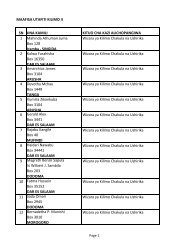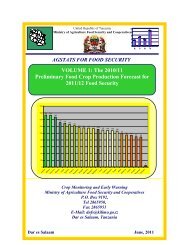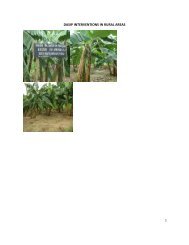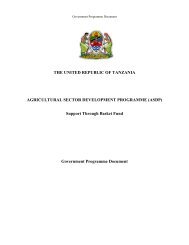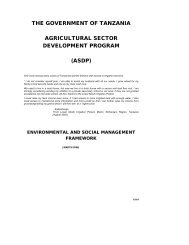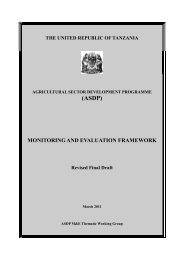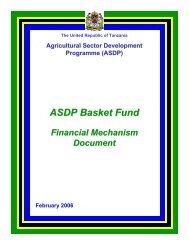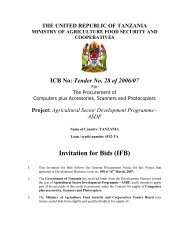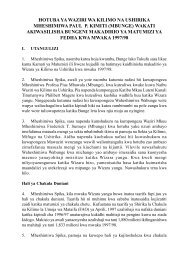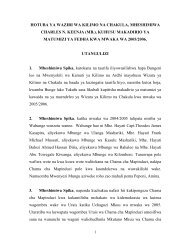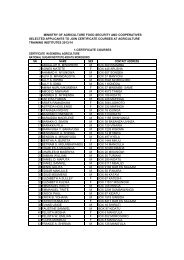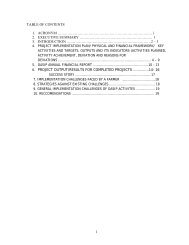Large Scale Farm Report - Ministry Of Agriculture, Food and ...
Large Scale Farm Report - Ministry Of Agriculture, Food and ...
Large Scale Farm Report - Ministry Of Agriculture, Food and ...
Create successful ePaper yourself
Turn your PDF publications into a flip-book with our unique Google optimized e-Paper software.
REGIONAL PROFILES77Mbeya has low number of chickens <strong>and</strong> most of the chickens are improved. The region produces the seventh largestnumber of eggs.The rate of disease infection in the region is moderate to low; Newcastle <strong>and</strong> Coccidiosis being more prevalent than others.In general, access to livestock infrastructure <strong>and</strong> services is moderate to low with access to veterinary clinic <strong>and</strong> inputsupply being the leading problems.Mbeya has relatively moderate to low number of farm employees. It has the 7 th largest number of temporary farmemployees <strong>and</strong> 6 th largest number of permanent farm employees. The number of male employees is higher than the numberof female employees.4.13 MwanzaMwanza has 76 large scale farms with a l<strong>and</strong> area totaling has the 13 th largest utilised l<strong>and</strong> area (approximately 2,000 ha)most of which is planted with annual crops, however permanent crops are also grown mainly as mixed crops with annualsbut also small amounts of permanent mono-crop st<strong>and</strong>s exist. The percent of l<strong>and</strong> available to large scale farms that wasutilised during the census year was the lowest compared to other regions. Mwanza has two planting seasons <strong>and</strong> the shortrainy season had a greater planted area than the long rainy season during the census year.The region has the moderate planted area of annual crops compared to other regions in the country. It has the tenth largestplanted area of maize, sixth largest planted area of paddy, fifth largest planted area of sorghum, third largest planted area ofcotton <strong>and</strong> has the second largest planted area of groundnuts in the country. Vegetable production in Mwanza is moderate.Permanent crops are not very important.The region has the twelfth largest planted area under irrigation. It has the eighth highest number of farms practicingirrigation. The region has moderate percent of large scale farms receiving agricultural extension advice in the country. Ithas low number of trees planted by large scale farms <strong>and</strong> a moderate number of farms with erosion control/waterharvesting structures. The most important types of erosion control / water harvesting structures are the water harvestingbunds, erosion control bunds <strong>and</strong> terraces.Mwanza has a moderate number of farm implements. It has the tenth smallest number of tractors <strong>and</strong> the twelfth largestnumber of harrows <strong>and</strong> it has the eighth largest number of ploughs. The region has no harvesters.On large scale farms, Mwanza has the fifth highest population of livestock. It has the third largest number of farms rearingcattle <strong>and</strong> the fourth highest population of cattle in the country. Most of them are indigenous. The region has the secondlargest number of farms keeping goats <strong>and</strong> sheep. However, it has a moderate number of goats <strong>and</strong> it is one of the regionswith the lowest population of pigs. It is one of the moderate to lowest milk producer in the country <strong>and</strong> the farm gate pricefor milk is low.The region has the fourth highest population of chickens in the country <strong>and</strong> most of them are improved chickens. Theregion has also the fourth highest number of eggs produced.Tanzania <strong>Agriculture</strong> Sample Census – 2003



